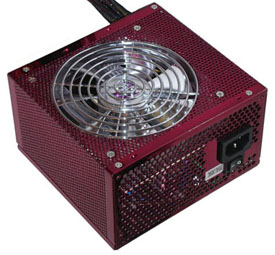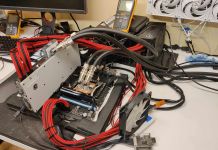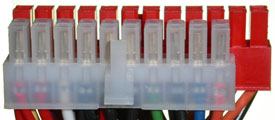At the dawn of time, there was only one power supply. It was that one you got together with the case you bought. Power supplies were not that important and the power rating were of moderate importance. Today, things got are a bit more complicated with new connectors and more specified power ratings on the power rails.
At the dawn of time, there was only one power supply. It was the one you got together with the case you bought. Power supplies weren’t that important and the power rating was of moderate importance. Today, things are a bit more complicated with new connectors and more specified power ratings on the power rails.
Just like graphic cards, for example, the development of PSU’s has been vertiginous. The voltages are produced the same way as before, but the esthetical appearance, fan noise and of course the power rating are now more in focus.
Today, we will take a closer look at a PSU manufactured by Hiper which we have bumped into earlier here at NordicHardware. Now it’s time to familiarize us with Hiper’s new flagship in their PSU series, the Type-R 480W. When one is talking about PSU’s Hiper all to often gets the “generic” label as they are still a quite unknown brand to the Swedish market. Now, when Hiper introduces the Type-R series they want to establish their name as a brand among the biggest name of manufacturers in PSU’s, Enermax and Antec. Our tests will show if Hiper can match its competitors when it comes to price and performance.
As ATX is an industry standard, the development of the specification is completely natural. E.g. there’re new connectors and new requirements regarding the voltages of the power supply. The ATX specification is not only to be used for PSUs, it spans from tolerances of the voltages to where the connectors should be located on the back plate of the computer.
The ATX rev. 2.2 specification, briefly explained, tells us that the PSUs following it should be equipped with a 24 pin motherboard connector. The new 24 pin connector follows the requirements to be able to supply enough power for motherboards with PCI-Express.
Another point in the specification tells us that the PSU should supply two independent rails of 12 Volts. This means that the PSU should deliver 12 Volts by two separate rails, one rail is housed in the 24 pin connector and the other rail comes via the ATX12V connector (the 4 pin connector).
We had, of course, the ATX connector and the ATX12V connector before, but the 12 V rail had the same source. S-ATA harddrive connectors are now also a part of the specification. As I mentioned above, there’s now new demands regarding the supplied power.
 |
 |
|
A development of the specification – Two different connectors
|
A new PSU to old motherboard converter |
| ATX 2.03 | ATX 2.2 | |||
|---|---|---|---|---|
|
Voltage
|
Tolerance
|
Ripple
|
Tolerance
|
Ripple
|
|
+3.3VDC
|
±5%
|
100mV
|
±5%
|
70mV
|
|
+5VDC
|
±5%
|
100mV
|
±5%
|
100mV
|
|
+12VDC1
|
±5%
|
100mV
|
±5%
|
120mV
|
|
+12VDC2
|
–
|
–
|
±5%
|
120mV
|
|
-5VDC
|
±10%
|
200mV
|
*
|
*
|
|
-12VDC
|
±10%
|
200mV
|
±10%
|
200mV
|
|
+5VFSB
|
±5%
|
100mV
|
±5%
|
70mV
|
* – The manufacturer may choose to utilize the -5VDC, but the is no requirement to fulfil the specification
Ripple, mentioned above, is (roughly simplified) unevenness embedded into the voltage, and it emerges or stays in the voltage when the AC current is rectified into DC current. The ripple increase when the output voltage is loaded. In all voltages from the PSU, the ripple is present and it has to measured with an oscilloscope to determine how much ripple there is in the voltage.
 |
|
|
The perfect DC current |
Ripple – Very magnified |
| Specifications | |
|---|---|
 |
|
|
Voltage/Current
|
|
|
+3.3VDC
|
28A
|
|
+5VDC
|
32A
|
|
+12VDC
|
18A
|
|
+12VDC (ATX12V)
|
16A
|
|
-5VDC
|
0.8A
|
|
-12VDC
|
0.8A
|
|
+5VSB
|
2.5A
|
|
Total maximum power
|
480W
|
|
Maximum power +3.3V & +5V
|
240W
|
|
Connectors
|
|
|
Molex
|
8
|
|
Floppy
|
2
|
|
Serial-ATA
|
2
|
|
Other
|
ATX12V
|
|
Other specifications
|
|
|
Fans
|
1pcs 120mm
|
|
Certifications
|
UL, CUL, VDE, SEMKO, DEMKO, NEMKO, FINKO och CB
|
|
Other
|
Gold plated connectors, 20->24 pin adapter, 1 case fan
|
|
Warranty
|
3 year
|
|
Price
|
~900 SEK
(Exchange rates) |
Even before you’ve opened the box, Hiper’s Type-R is an interesting PSU. The retail package of the PSU is in contradiction with the general opinion that a PSU arrives in a simple cardboard box.
Instead, Hiper chooses a quite spectacular solution, a plastic “lunch box” with handles. The box even contains a small Christmas gift for the computer enthusiast. It should be mentioned that the size of this “gift” depends on the color of the PSU. The PSU comes with a 3 year warranty and there’s not much to say about that except that Hiper seem to believe in themselves. We’ll see about that later in the tests. PCI-Express connectors are not mentioned in the table above and there’s an explanation to why that is. These connectors were implemented in PSUs manufactured after Jan -05 and our PSU is of an earlier model.
 |
 |
Type-R comes in three colours, Silver, Black and Red. The big difference is the color and along with the color comes slightly different accessories. The black PSU have an UV reactive braided cables while the silver coloured one have, you guess it, silver braiding and the red PSU comes with a black braiding.
An 80mm case fan comes with all three colours. The fan that comes with the red PSU is equipped with red LEDs and the fan that comes together with the silver and black PSU don’t have any LEDs at all.
The PSU comes wrapped up in a plastic bag to protect it from scratches, which is needed since the PSU has a mirror finish.
 |
 |
 |
 |
The connectors of Molex type utilize the”Ez-Grip”. It simplifies the disconnection from hard drives, optical units etc. as you squeeze the hoop on each side of the connector and the hoop pushes the connector out of the socket, a both smart and innovative solution.
In case you choose the silver coloured PSU, you’ll get a pair of rounded ATA-133. Hiper explained to me why and I quote ”The reason we put the round IDE cable in the silver one is because it has metal braiding and we thought that this would be very hard to find in the market place where as UV cables to match the black label and red cables to match the red label are very common.”.
 |
 |
|---|
The rounded ATA cables are pretty nice, BUT there are only sockets for one unit on them. That is a obvious drawback as there’s plenty of people that utilize more than one unit per IDE channel. On the internet or even in your local computer hardware store you most probably can buy rounded cables but it’s sad, or even really bad, as these cables should be used together with the silver PSU. So if you decide to buy the silver coloured PSU and use more than one unit per IDE channel you can forget about the cables.
Our tests are performed in two parts, one low-power test and one high-power test. The PSU runs for about 30 minutes with an opening low-power test followed by a high-power test.
In the low-power test, the three main voltages (+3.3V, +5V and +12V) are put under a load of about 1 Ampere, except for +5V which has a load of 2 Ampere (to comply to the minimum requirements specified for the PSU). This is to see how the PSU works when ”idling”.
In the high-power test, the three voltages are put under maximum load, to see if the PSU can hold the voltages and ripple within the threshold values. That is to see if the PSU can keep its promises.
During both tests the voltages and ripple are measured continuously. The second part is done in a regular computer. Since Hiper has ambitions to become one of the big names on the PSU market I chose to do the exact same test on a PSU made by Antec, a Neopower 480W. Both PSUs have the same maximum output, 480 Watts, but the power is divided somewhat differently between the voltages.
|
Low power test
Voltage | ||||||||||||||||||||||||||||||||||||||||||||||||||||||||||
| ||||||||||||||||||||||||||||||||||||||||||||||||||||||||||
| ||||||||||||||||||||||||||||||||||||||||||||||||||||||||||
Hiper has no problems in the low-power test. The voltages are very stable and the ripple is well below the threshold values. The PSU has a slight over-voltage on all feeds except for the 5-Volt feed, which is entirely acceptable since it is a 480 Watt supply unit now under a 30 Watt load.
I choose not to make a ripple diagram in the low-power test since both PSUs have a ripple below 10 mV. The really interesting values aren’t seen before the PSU is put under full load, 480 Watts. Antec’s PSU doesn’t have any problems with the low-power test either, and neither should it. With that, we move on to the high-power test.
|
High power test
Voltage | ||||||||||||||||||||||||||||||||||||||||||||||||||||||||||
| ||||||||||||||||||||||||||||||||||||||||||||||||||||||||||
| ||||||||||||||||||||||||||||||||||||||||||||||||||||||||||
|
High power test
Ripple | ||||||||||||||||||||||||||||||||||||||||||||||||||||||||||
| ||||||||||||||||||||||||||||||||||||||||||||||||||||||||||
| ||||||||||||||||||||||||||||||||||||||||||||||||||||||||||
After about 30 minutes of maximum load, the fan is running at high speed and the PSU is lukewarm but our testing bench is hot, not to say red-hot. After cranking out 480 Watts of pure heat, the PSU has no problems at all, but we have to let our bench rest for a while. But first we have to take the last measurements. The voltages and ripple are well within threshold values. Of course, the voltages have decreased compared to the low-power test, which is completely normal since we are putting the PSU under maximum load.
The ripple isn’t a problem either. Ripple values at least 50% below threshold values is very good. The Hiper designers have really done well here. Type-R is close to a top placement, and with due right.
There are very few lowbudget, or even mid, PSUs that can perform like this at maximum power output. Now the Type-R isn’t intended to be a budget unit, but with its pricetag it is in the range where it could be called budget, but it performs like the best on the market.
Type-R is right behind Antec’s Neopower, and we have to say that the Neopower is a very good PSU. The tiny difference between them is that the Type-R voltages are slightly lower than those of the Neopower, but it is so little and so far from threshold values that it can be neglected in my humble opinion.
The fan, by the way, is running at high speed, and this is no 18 dB. Rather somewhere around 30 dB, but it is still not disturbing since there are many components in a computer that make much more noise. In a comparison with Antec’s PSU, which also uses a 120 mm fan, both produce just as much noise.
|
Testsystem Computer
|
|
| Cpu: |
AMD Athlon Mobile 2500+
|
| Chassis: |
Asetek Vapochill SE
|
| Mainboard: |
Asus A7N8X Deluxe rev 2.0 |
| Memory: |
512MB OCZ 3500 EL DDR-SDRAM |
| Graphic card: |
Abit Siluro FX5600 256Mb |
|
HDD:
|
200 GB, 160 GB Maxtor Diamond Max9 8 MB cache
|
|
Software
|
|
| Operating system: |
Windows XP Professional SP1
|
|
Testprogram:
|
Sisoftware Sandra 2004 |
The testsystem is based upon Socket A, overclocked to 2.6 Ghz. Two HDDs and one low-end graphic card makes the foundation of the system. But what really consumes power is the overclocked cpu and its cooling. A overclocked cpu consumes alot more power than a normal one . In this case it consumes roughly about 114 Watts compared to the original 45 Watts.
The cooling is composed of a compressor system, which can be pretty tough on the power supply, in this case the 12V voltage. A compressor contains an engine which isn’t very nice to a power supply due to that it is a big inductive load. Well then, now we have shown the conditions, lets start..
| Testsystem computer |
|||||||||||||||||||||||||||||||||||||||||||||||||||||||||||||||||
|
|||||||||||||||||||||||||||||||||||||||||||||||||||||||||||||||||
|
|||||||||||||||||||||||||||||||||||||||||||||||||||||||||||||||||
After having run the power supply in our test computer with mixed assigments it’s clear that Type-R works exactly as it shall. It provides the voltages demanded by the computer, and that without to much work. The voltage varies a bit but are within the guidelines. What really suprises me is that the 12 voltage isnt lower due to the compressor going up and down, to keep the cpu-cooling at a smooth level. The noise from the fan was barely audible under the test. The fan is really quiet and what was told about it before was when it were at full load, 480W.
Hiper wanted to make themselve a name with Type-R and here they hit the right spot. Type-R can actually be classed as ”High-end”.
A power supply can be produced in two ways, actually three. The first way is to manufacture a supply with cheap components to get a low price. It’s often these supplies we get with the chassis we buy, provided that its not a special brand.
The other way is to make a living out of ones previously earned name. But with that I’m not saying that any of the big manufactures are doing this. The third way is to use ones constructors well, and dont save on the components that are used. Even if you let the contructors produce a great design on the supply and it performs well in a laboratorium, although it can still become terrible when costs on the components are cut.
Hiper has chosen the third way. They have used their staff well and produced a supply that performs as well as the biggest on the market.
With a price tag on ca 900 SEK is the Type-R 480W a very good buy. The supply is very cool with its varnish and it’s definitely an eye drawer. The fan is very quiet and is suited for the one who seeks components to a quiet computer, but it also works for the enthusiast computer player that need power for the new graphic card. Rippel and voltages are within specifications, by a margin, and can match the more expensive supplies when it comes to price/perfomance. With its ATX 2.2 specification the supply is prepared för all new mainboards with PCI-express and HDDs with Serial-ATA.
The only thing negative I can find with Type-R is the accessorie to the silvercolored supply, the ATA-cable. One socket is one socket to little. If you use two units per IDE-channel you cant use the cable.
Overall the Hiper Type-R is a very attractive powersupply, literally speaking, that we can recommend to all out there who’s after a power supple that’s price worthy and has good perfomance.

Pros:
+ ATX 2.2 Specification
+ Stable voltages
+ Very Silent
+ Color adapted accessories
+ Price
Cons:
– Only one socket on ATA-cable























Leave a Reply